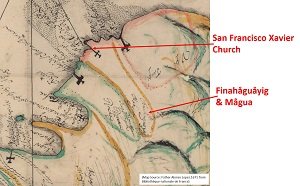Home
Indexed Transcribed Land Records (Work In Progress)
- Details
- Written by: Bernard Punzalan

Building More Tools for the Next Generation of CHamoru Genealogy and History Researchers ...
Sometime between 1958-1959 Dr. Domingo Abella was commissioned to translate, into English, land records of title in original Spanish manuscript from 1895-1906. These land records were comprised of four primary jurisdictions on Guåhan: Hågåtña (most places fell here), Hågåt, Inalåhan, and Malesso. These records have since been digitized by the Department of Land Management, Government Guam.
Although the Index currently remains a work in progress, once I am able to complete and publish, it will serve as another genealogy tool and quick reference companion copy to those land records. The names listed in the Index are the land owners, their age and marital status (if recorded), the year of the record, estate number, property location and the page number for Abella’s transcription.
It is interesting to note that in some of these land records an “alias” for a person was identified. In general, these “alias” seem to be the person's family clan name, so I left some field space on this Index for those that did have their clan name identified.
Mågua & Finahåguåyig: Ancient Villages on Guåhan
- Details
- Written by: Bernard Punzalan

From a 1676 map of Guåhan produced by Father Alonso, he depicted where the Jesuits strategically placed churches in populated villages of natives. Up in the northwestern part of the island pertinent to the villages of Mahgua [Mågua] and Finahaguoyig [Finahåguåyig], the Jesuits established the Church of San Francisco Xavier as part of their overall outreach and Catholic conversion of the natives.
Francisco Xavier/Javier was a popular name during the religious conversion and conquest period. It is also the baptismal name given to one of the first four children San Vitores baptized sometime in the afternoon of June 16, 1668, while aboard the “San Diego,” a patache he and his crew first arrived on in the Mariana Islands.
The following year in 1669, there was a sickly three-month-old child from Fu’una, Rota. Father Francisco Garcia described the infant as lying stiff as a board for six hours and was expected to die. After Father San Vitores baptized him and said his prayers, he took the infant into his hands, and just when the signs of life seemed to have disappeared, the child moved and his breath and color were restored. It was a testament of faith for the moment. Unfortunately, Francis Xavier lived for only ten days and died on December 10, 1669. San Vitores named him in honor of the Feast for Saint Francis Xavier, which occurred the day of his baptism on December 1, 1669.
References:
Francisco Garcia. 2004. The Life and Martyrdom of the Venerable Father Diego Luis de San Vitores , S.J . Translated by Margaret M. Higgins, Felicia Plaza and Juan M.H. Ledesma. Edited by James A. McDonough. MARC Monograph Series 3. Guam: University of Guam
Augusto V. de Viana. 2004b. In the Far Islands: the Role of Natives from the Philippines in the Conquest, Colonization and Repopulation of the Mariana Islands. University of Santo Tomas: Manila, Philippines.
The Fratis Family of St. Paul Island, Alaska (Part IV)
- Details
- Written by: Bernard Punzalan
In 2014, I was researching portions of the Chamorro diaspora that may have been listed in the 1900 US Census. It was at that point when I discovered the Fratis family, descendants of CHamoru ancestry, recorded in St. Paul Island Alaska. Since then, I have written three articles documenting my journey to try and find out more of their history. It begins with the name of John Fratis, a “Chamorro,” who made his way to Alaska around March 1869 as a whaler.
In a recent FaceBook group conversation with Orion-Julie Mendiola, he had pointed out to me that there were videos of the Greg Fratis telling the history of his family. He shared the YouTube links with me and I have re-posted here.
Gregory Fratis Sr. teaching the history of the Fratis Family:
1. Fratis Family History Part 1 of 3:
2. Fratis Family History Part 2 of 3:
3. Fratis Family History Part 3 of 3:
Previous articles covering my research on the Fratis family history:
1. Bernard Punzalan. 2014a. 1900 US Census: Chamorro Diaspora. Chamorro Roots Genealogy Project. From: https://www.chamorroroots.com/v7/index.php/49-taotao-tano/history/298-1900-us-census-chamorro-diaspora
2. Bernard Punzalan. 2014b. The Beginning of Taotao Håya-Unangan (Chamorro-Aleut) Clan: The Legacy of John Fratis and His Descendants. Chamorro Roots Genealogy Project. From: https://www.chamorroroots.com/v7/index.php/49-taotao-tano/history/297-the-beginning-of-the-taotao-haya-unangan-chamorro-aleut-clan-the-legacy-of-john-fratis-and-his-descendants
3. Bernard Punzalan. 2014c. John Fratis and His Descendants (Part II). Chamorro Roots Genealogy Project. From: https://www.chamorroroots.com/v7/index.php/home/collaborators/49-taotao-tano/history/295-john-fratis-and-his-descendants-part-ii
4. Bernard Punzalan. 2018. John “Kuk/Cook” Fratis (Part III). Chamorro Roots Genealogy Project. From: https://www.chamorroroots.com/v7/index.php/9-taotao-tano/544-john-kuk-cook-fratis-part-iii
(Special thanks to Orion-Julie Mendiola for the links to these videos.)
Rare 1676 Map of Guahan with Ancient Village Names
- Details
- Written by: Bernard Punzalan
The 1676 map of Guåhan listing the names of over 100 ancient villages may be obtained at this link:

Special thanks to Dr. Carlos Madrid identifying this source and his presentation translating the text on the map:
1676 Map of Guam {artsexylightbox color="white" autoLoad="true"}{/artsexylightbox}
Site Upgrade/Maintenance Notice
- Details
- Written by: Bernard Punzalan
Happy New Year!
I will be updating many of the modules of this website to bring it up to par so some screens may not look the same or may be inoperable.
These updates should not affect the Chamorro Roots Genealogy Project Database, but if it does or if experience any issues please fill out the Contact Us form to report the issue(s) and I will look into it.
Thanks for your understanding and patience as I apply some of these changes.
Page 26 of 81